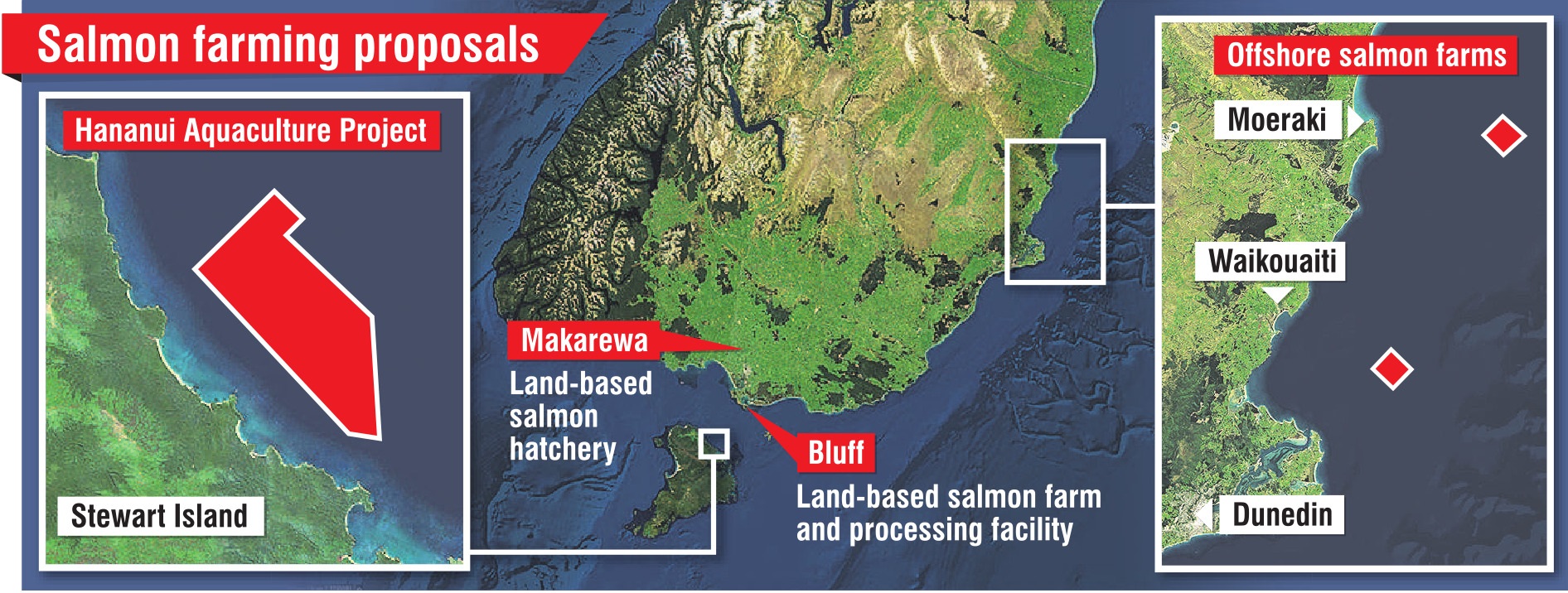
Another aquaculture project, Ngāi Tahu Seafood's Hananui Aquaculture Project, is on the new fast-track list after an earlier bid for fast-tracking was declined because of its potential to harm a pristine environment.
Regional Development Minister Shane Jones said yesterday his party, New Zealand First, had long aimed for a more liberal approach to aquaculture, "and for aquaculture to be scaled up by billions of dollars".

Sanford Limited’s Project East - about 15km north of Otago Harbour - was listed as "shovel ready" in the Independent Advisory Group report to ministers which was released last week.
The report provided details on 384 projects which applied to be listed in the government’s Fast Track Approvals Bill.
"The Project East project is to establish and operate two open ocean salmon farming areas, with each farming area being approximately 20ha", the report said.
"Development would be staged and at full development the project will yield an expected 24,000 tonnes of salmon per year across both farms."
Aiding the growth of aquaculture through fast-track consents should allow the sector to significantly increase its contribution to the regional and national economy, the advisory group report said.
"The global demand for seafood protein from a sustainable blue economy is only forecast to continue growing, in concert with the expansion of the middle classes in developing nations.
"The New Zealand aquaculture sector is well placed to contribute to that growing demand in a sustainable and climate friendly manner", it said.
Alongside Project East, Sanford also had its Makarewa Hatchery project, a land-based recirculating water salmon hatchery on a 24ha former abattoir site, in Southland, listed among the 149 projects selected nationally for inclusion in the government’s one-stop-shop consenting Bill, expected to be passed into law by the end of the year.
A third project, its Sanford Second Greenshell Mussel Spat Hatchery, a land-based operation in Canterbury, was also listed.
A Sanford spokeswoman declined to comment yesterday.
However, in a consent application for Project East to the Otago Regional Council in May last year, two sites were identified for the Otago salmon farms.
One was identified as being 15.5km off Taiaroa Head, or 15.6km off Waikouaiti’s coast. The other was 18.7km from Moeraki.
Each of the farming areas would include up to 20 individual floating pens.
They would be circular structures inter-connected by a grid of sub-surface lines, and moored to the ocean floor.
A centralised barge - "likely one per 10 pens" - would service the farms, with feed delivered to each pen through hoses or pipes.
A winch system would allow the pens to be lowered during storms, the application said.
The farming areas were chosen in areas where the seabed afforded "no ecologically significant benthic habitat".
They were outside proposed marine protected areas.
They were more than 5km offshore to minimise visibility from land.
And they were outside informal shipping lanes.
Further, there was more than 8km between the areas, providing for fish health and biosecurity reasons, the application said.
Mr Jones said he hoped promoters of large-scale projects such as Project East "do step up to the plate" and go through the eventual fast-track legislation.
"Because the South Island needs to diversify the ranges of its job, revenue and development activity.
"I realise that there will be other views as to whether or not the coastline off Te Waipounamu should even be used for this purpose, but we're a coastal nation and I think there's tremendous potential out there for investors, both domestic and international, to expand the productive base of our aquaculture sector", he said.
Mr Jones also lamented the decision to decline Ngāi Tahu Seafood's Hananui project last year,
"In my view, economic potential has been traded off far too frequently in the pursuit of faint environmental concerns.
"And we've got to ensure that we stop overstating risks and understating costs and trust in mitigative measures to cope with perceived risks to the environment."
Ngāi Tahu was approached for comment yesterday, but could not respond by press time.
The decision to decline the iwi’s Hananui Aquaculture Project salmon farm in Te Ara a Kiwa-Foveaux Strait was made with a "heavy heart", the expert panel said last year.
"However, the large scale and dispersed salmon farms will result in a major step change to a receiving environment that is relatively unmodified by human activities, with very high natural character from a notable absence of any permanent marine structures and a relatively low level of human activity, except transiting and anchoring vessels", the decision, released in August last year, said.
Forest & Bird Otago-Southland regional conservation manager Chelsea McGaw said she had been pleased by the decision at the time.
There was a breeding colony of hoiho (yellow-eyed penguins) "very, very close" to where the farms were proposed to go.
The birds had been the subject of a tracking study a few years ago and they travelled throughout the proposed area when foraging, she said.
A fourth southern project, Impact Marine’s land-based salmon farm, included a proposal to build and operate a salmon farm hatchery, smolt and grow-out facilities as well as a plant and associated buildings at Bluff.
In total, the independent advisory group assessed 28 aquaculture projects, and seven made it to the government's first list for the Bill.













